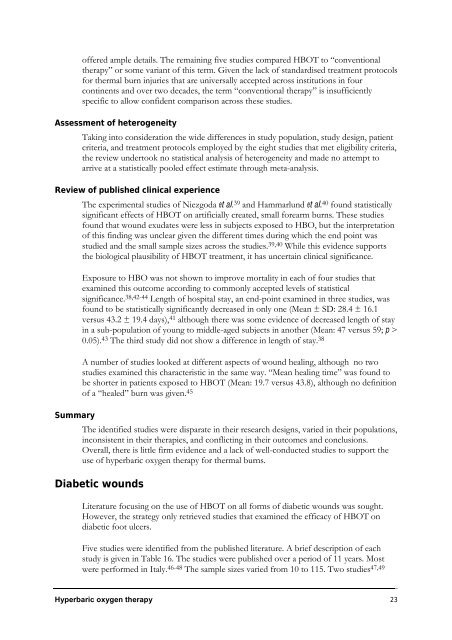Hyperbaric Oxygen Therapy - Hyperbaric Chamber Information ...
Hyperbaric Oxygen Therapy - Hyperbaric Chamber Information ...
Hyperbaric Oxygen Therapy - Hyperbaric Chamber Information ...
You also want an ePaper? Increase the reach of your titles
YUMPU automatically turns print PDFs into web optimized ePapers that Google loves.
offered ample details. The remaining five studies compared HBOT to “conventional<br />
therapy” or some variant of this term. Given the lack of standardised treatment protocols<br />
for thermal burn injuries that are universally accepted across institutions in four<br />
continents and over two decades, the term “conventional therapy” is insufficiently<br />
specific to allow confident comparison across these studies.<br />
Assessment of heterogeneity<br />
Taking into consideration the wide differences in study population, study design, patient<br />
criteria, and treatment protocols employed by the eight studies that met eligibility criteria,<br />
the review undertook no statistical analysis of heterogeneity and made no attempt to<br />
arrive at a statistically pooled effect estimate through meta-analysis.<br />
Review of published clinical experience<br />
The experimental studies of Niezgoda et al. 39 and Hammarlund et al. 40 found statistically<br />
significant effects of HBOT on artificially created, small forearm burns. These studies<br />
found that wound exudates were less in subjects exposed to HBO, but the interpretation<br />
of this finding was unclear given the different times during which the end point was<br />
studied and the small sample sizes across the studies. 39,40 While this evidence supports<br />
the biological plausibility of HBOT treatment, it has uncertain clinical significance.<br />
Exposure to HBO was not shown to improve mortality in each of four studies that<br />
examined this outcome according to commonly accepted levels of statistical<br />
significance. 38,42-44 Length of hospital stay, an end-point examined in three studies, was<br />
found to be statistically significantly decreased in only one (Mean ± SD: 28.4 ± 16.1<br />
versus 43.2 ± 19.4 days), 41 although there was some evidence of decreased length of stay<br />
in a sub-population of young to middle-aged subjects in another (Mean: 47 versus 59; p ><br />
0.05). 43 The third study did not show a difference in length of stay. 38<br />
A number of studies looked at different aspects of wound healing, although no two<br />
studies examined this characteristic in the same way. “Mean healing time” was found to<br />
be shorter in patients exposed to HBOT (Mean: 19.7 versus 43.8), although no definition<br />
of a “healed” burn was given. 45<br />
Summary<br />
The identified studies were disparate in their research designs, varied in their populations,<br />
inconsistent in their therapies, and conflicting in their outcomes and conclusions.<br />
Overall, there is little firm evidence and a lack of well-conducted studies to support the<br />
use of hyperbaric oxygen therapy for thermal burns.<br />
Diabetic wounds<br />
Literature focusing on the use of HBOT on all forms of diabetic wounds was sought.<br />
However, the strategy only retrieved studies that examined the efficacy of HBOT on<br />
diabetic foot ulcers.<br />
Five studies were identified from the published literature. A brief description of each<br />
study is given in Table 16. The studies were published over a period of 11 years. Most<br />
were performed in Italy. 46-48 The sample sizes varied from 10 to 115. Two studies 47,49<br />
<strong>Hyperbaric</strong> oxygen therapy 23



